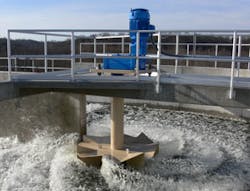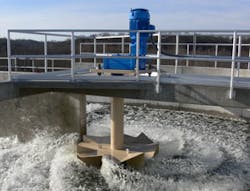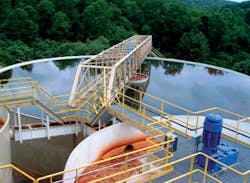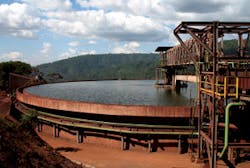Acid Mine Drainage: A Reusable Water Resource
By Jeff Easton
Acid mine drainage (AMD), produced from coal and mineral mining operations, presents a difficult and costly problem. With the sheer volume of AMD sites and the contaminants associated with them, it has been described as the largest environmental problem facing the U.S. mining industry, according to the Environmental Protection Agency (EPA).
In the eastern U.S., more than 4,000 miles of streams are affected by AMD from coal mines, according to the U.S. Forest Service. In the western U.S. alone, between 20,000 and 50,000 mines are currently generating acid on Forest Service lands, and the drainage is impacting between 5,000 and 10,000 miles of streams. In addition to the acid contribution to surface waters, AMD may cause metals such as arsenic, cadmium, copper, mercury, silver, and zinc to leach, with potential harmful effects on humans, animals and aquatic ecosystems.
AMD from mine waste rock, tailings and mine structures such as pits and underground workings is primarily a function of the mineralogy of the rock material and the availability of water and atmospheric oxygen. It is the formation and movement of highly acidic water, rich in heavy metals, which are leached from rocks that come in contact with the acid.
This acidic water forms through the chemical reaction of surface water (i.e., rainwater, snowmelt, pond water) and shallow subsurface water, with rocks that contain sulfur-bearing minerals, resulting in sulfuric acid. The acid is generated when metal sulfide minerals are oxidized, which are present in the rock associated with most types of metal mining activity.
AMD is typically characterized by low pH and high dissolved iron. It may also contain high amounts of CO2, which forms carbonic acid, further depressing the pH. When the pH of AMD is raised past 3.0, either through contact with fresh water or neutralizing minerals, previously soluble iron ions precipitate as iron hydroxide, a yellow-orange solid colloquially known as "yellow boy." Other types of iron precipitates are possible, including iron oxides and oxyhydroxides.
All of these precipitates can discolor water and smother plant and animal life in the streambed, disrupting stream ecosystems. The process also produces additional hydrogen ions, which can further decrease pH. Elevated levels of heavy metals can only be dissolved in waters that have a low pH, as can be found, for example, in the acidic waters produced by pyrite oxidation.
Treatment Options
A number of treatment methods can be employed to meet EPA and state-mandated effluent discharge levels. The determination of these options is dependent upon the flow rate; receiving stream's flow and quality; availability of electrical power; distance from chemical addition to where the water enters a settling pond; and the pond's volume for water retention time. After evaluating these variables, the economics of different chemicals and alternative treatment systems can be assessed.
The types and amounts of metals in the wastewater strongly influence the selection of an AMD treatment system. Enough alkalinity must be added to raise water pH and supply hydroxides so that dissolved metals in the water will form insoluble metal hydroxides and settle out. Because AMD contains multiple combinations of acidity and metals, each one is unique, and its treatment may vary widely from site to site.
The simplest treatment of AMD involves: a) neutralization of acidity and b) precipitation of metal ions. The most commonly used neutralizing agent is lime, which is added to previously precipitated solids in a densification tank to produce a high-density sludge (HDS). Excess CO2 dissolved in the AMD stream can be stripped out using a surface aerator; this step also begins to oxidize iron and manganese and assists in their precipitation. After stripping, the HDS slurry and AMD stream are mixed in reaction/aeration tanks. The combination of aeration, high pH and mixing causes the iron, manganese and other heavy metals to precipitate to the fullest extent possible at a set pH level. Treated water then flows to a thickener for sludge thickening and clarification of the water.
The metal precipitates as sludge, and a portion of the sludge is recycled to the sludge densification tank; the remainder of the sludge goes to disposal. Depending on the site conditions, the thickened waste sludge may be redirected to another portion of the mine, dewatered and deposited prior to disposal in a landfill or concentrated to paste and stacked. A gravity sand filter may be used to polish the stream prior to discharge, depending on permit limits. If low total dissolved solids (TDS) is required for downstream processes, then ultrafiltration and reverse osmosis (RO) can be added to the system to produce this level of high-quality effluent.
Since AMD sites are often in mountainous, uninhabited areas where access to the site may be difficult, many of these systems are built for ease of operation, with no on-site operator. This has led to the use of caustic for neutralization, which is easier to feed into the AMD stream than lime. Caustic is also typically used for smaller drainage flows.
AMD Water Reuse, Reclamation
While the majority of wastewater streams generated from AMD are characterized by low pH (2-4) and high levels of dissolved iron (1,000-10,000 ppm), there are some AMD streams that are not contaminated to these extremes. These streams may have relatively high pH levels (5-7) and dissolved iron levels as low as several hundred ppm. With water sources becoming harder to obtain for industrial applications, these marginal-quality water streams are becoming more attractive for reclamation and reuse.
Implementing sustainable and financially viable methods to reuse vast quantities of acid mine water is an area of relatively new, but growing, interest for mining operations. The technologies exist to economically treat any strength of AMD for industrial reuse. Recent technological refinements in such processes as CO2 stripping, aeration, thickening/clarification, sludge disposal, ultrafiltration, and RO are making these systems more streamlined and efficient, enabling full-scale AMD reuse projects to not only control, manage and reuse contaminated water streams, but also to make these projects financially viable.
For example, the latest developments in high-rate thickeners, used to separate liquids and solids at very high rates, are highly effective in coal refuse thickening, gold recovery, copper leaching, molybdenum processing, and other mining and chemical applications. Separation is effected rapidly because of this system's hydraulics, which can be in excess of 20 times that of conventional thickeners. As a result, the plant area required for this new generation of thickeners is greatly reduced. The smaller equipment size substantially reduces capital, installation costs and plant space when compared with conventional thickening units sized for the same production rates.
There have also been recent advancements in surface aerator technology. New impeller designs increase oxygen transfer efficiency and reduce axial and radial loads. Such a system can produce a minimum efficiency of 3.8 pounds of oxygen per horsepower-hour. This improved transfer efficiency saves significant operational costs over the life of the equipment. The reduced axial and radial loads increase the life of the drive unit and reduce the size of support structures and beams for the surface aerators. Systems like these are making AMD reuse more accessible for mining operations, which require systems to be financially feasible as well as capable of efficiently handling waste streams within a confined footprint.
Such technology was recently put to use in a coal-fired power plant in West Virginia, which contracted to access wastewater from a large AMD reservoir at an abandoned coal mine. In addition to other processes, the plant utilized the latest advancements in surface aeration to treat the water prior to decanting to the power plant. Consuming 3,000 gallons per minute (GPM), the entire reservoir was eventually depleted, at which point the coal mine went back into operation but is now producing coal for the power plant. The advanced surface aeration process was critical in facilitating an economically feasible solution for treatment of the AMD wastewater.
AMD reuse in hydraulic fracturing (fracking) for shale oil and gas production is quickly becoming a hot topic of interest. More than 300 million gallons of polluted water are discharged daily from abandoned coal mines into Pennsylvania waterways. The problem has persisted for decades, largely because costs associated with cleaning are so enormous. In 2013, the Pennsylvania Department of Environmental Protection issued new policies that support natural gas drilling companies in using abandoned mine drainage as a source of water for fracking. Until recently, in Pennsylvania, the use of AMD from abandoned coal mines had not been a viable option.
Many current Marcellus shale oil and gas fracking wells are in close proximity to AMD areas, creating a unique opportunity to beneficially use these drainage wastewater sites for fracking. According to a 2013 Duke University-led study, much of the naturally occurring radioactivity (radium and barium) in fracking wastewater might be removed by blending it with wastewater from AMD. Blending them can bind some fracking contaminants into solids that can then be removed before the water is discharged back into waterways. It would also help reduce the depletion of local freshwater resources by giving oil and gas drillers a source of usable recycled water for the fracking process.
As EPA mandates continue to tighten allowable limits on dissolved minerals and toxicity in our nation's watercourses, abandoned mines -- which were previously within EPA limits -- are now required to more aggressively treat their contaminated effluent to comply with the new standards. Consequently, mine operators are under increasing necessity to embrace more streamlined and cost-efficient water treatment technologies to process their acid mine wastewaters prior to discharge.
With the advent of these highly-optimized treatment technologies, however, new possibilities for water recycling and reuse have emerged that open up options for the safe disposition of these toxic wastewaters. And importantly, new options have been introduced that streamline the costs associated with AMD processing.
About the Author: Jeff Easton is a principal process engineer at WesTech Engineering, Inc., where he has worked for the last 25 years. He has a bachelor of engineering degree from the University of Utah and is a registered professional engineer. His field of expertise is liquid-solids separation, including a broad background in physical-chemical and biological processes.



